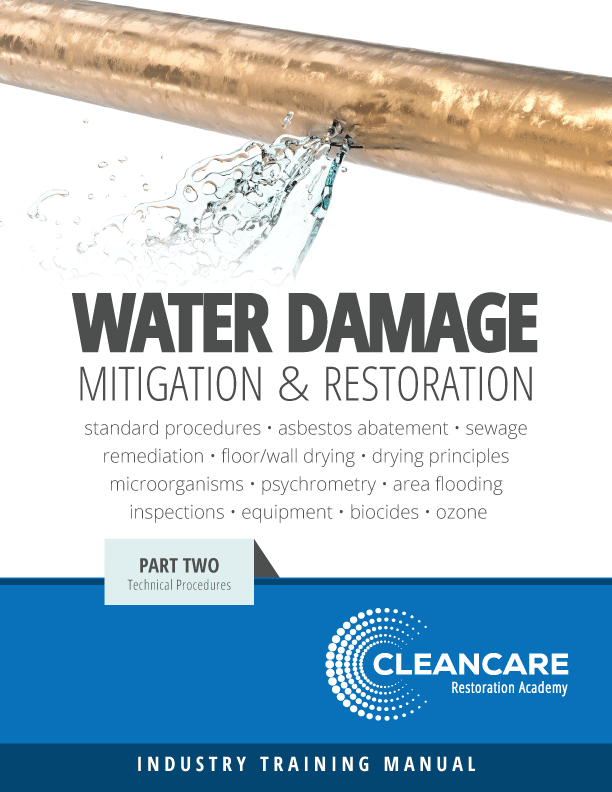Why PAS Should be Approved on Every Water Damage Job
Insurance adjusters who do not authorize and approve the use of HEPA-filtered Portable Air Scrubbers (PAS) on all water loss jobs may want to rethink their position.

Insurance adjusters who do not authorize and approve the use of HEPA-filtered Portable Air Scrubbers (PAS) on all water loss jobs may want to rethink their position. Any water loss poses a significant opportunity for particle contamination and for microscopic bio-pollutants such as fungi (molds) and bacteria that thrive in wet indoor environments to proliferate. Even smaller water leaks or overflows of sanitary water can ultimately trigger fungal growth if wet materials are not promptly identified and thoroughly dried.
It is very important to note that the very activities undertaken to remediate the problem can increase the risks of air contamination. For example, as forced-air drying evaporates water from surfaces, carpet and other materials, contaminants such as fungal spores and ultra-fine dirt and dust particles are likely to be released into the air. Once aerosolized (suspended in air), workers exposed to these pollutants can inhale them. Particles stirred up during remediation also create housekeeping and cleanup issues that can increase the cost of the cleanup.
The Institute for Inspection, Cleaning and Restoration (IICRC) has developed an ANSI-approved standard for water damage remediation. Now in its third edition, ANSI/IICRC S500-2006 Standard and Reference Guide for Professional Water Damage Restoration places water hazards into one of three contamination categories based on the quality of the water after it comes in contact with building materials:
- Category I – Water that originates from a sanitary source and does not pose substantial risk from dermal, ingestion or inhalation exposure.
- Category II – Water with a significant amount of contamination and the potential to cause discomfort or sickness if ingested by humans.
- Category III – Grossly contaminated water that can contain pathogenic, toxigenic or other harmful agents.
Types Of Indoor Air Pollutants
The Centers for Disease Control and Prevention (CDC) places air pollutants into three general categories: particulates, bio-aerosols, and volatile organic compounds (VOC), all of which may be released into the air during or following a water loss event.Particulates
Particulates from building materials are primarily released into the indoor air after the event or during the remediation process as opposed to during the water loss event itself. These commonly include dirt, drywall, VCT and concrete dust, fiberglass, carpet and asbestos fibers, sawdust, smoke particles, and metal fumes.
Larger, visible particles and smaller particles that agglomerate (clump together) will likely settle onto surfaces within minutes and remain there until physically removed by cleaning or vacuuming. These particles are not generally a respiratory health issue, because they are too heavy to remain aerosolized for very long.
Studies have shown, however, that more than 99% of the particles suspended in air are ten microns (0.0004 inches) or less in size. That’s five to 10 times smaller than a human hair and smaller than we can see with the naked eye. Particles and allergens this tiny are typically light enough to remain aerosolized for long periods of time and can readily spread through a building or home on air currents, and they are easily re-aerosolized when they do settle onto surfaces. They also pose the greatest potential health threat:
"While larger particles (those greater than 10 microns in diameter) get caught in the nose and throat, and are cleared naturally by coughing or swallowing, particles smaller than 10 microns in diameter are easily inhaled into the lungs. Of these, the smallest particles are most likely to reach the alveoli, where they can remain embedded for years, or in the case of soluble particles, be absorbed into the bloodstream. For this reason industrial hygienists often refer to them as ‘lung damaging particles’.
Bioaerosols are particulate remains from living matter, including microbial pollutants such as bacteria, fungal spores (molds, mildews and yeasts), arthropods (dust mites), algae, insect remains, pet dander, and pollens. With the exception of plant spores and pollens, virtually all bio-aerosols fit into the 10-micron or smaller category, ranging from 0.01 microns (four one-millionths of an inch) up to one to 10 microns (four ten thousandths of an inch).
The three fungal species most prevalent indoors - Aspergillus fumigates, Aspergillus flavus, and Aspergillus niger -are known to cause allergic reactions such as sinusitis, rhinitis, headaches and itchy or watery eyes, and more serious infectious diseases such as meningitis, osteomyelitis, aspergillosis, aspergilloma and ABPA. Wet indoor environments are also an excellent habitat for Stachybotrys chartarum (‘black mold’), Penicillium, and Histoplasma among others. These environments provide near perfect growth conditions, ample organic-based nutrient sources such as dirt and dust particles, wallboard and other commonly used cellulose-based building products, and favorable temperature and moisture conditions.
Health researchers have identified exposure of sensitive or immune-compromised hospital patients to Aspergillus fungal spores attached to dust particles released into the air during facility construction and renovation activities as the cause of serious infectious illnesses and even deaths. Based on these findings, CDC instituted stringent infection-control measures for all facility construction and renovation activities in health care facilities, including the use of HEPA filtered AFD (air filtration devices) such as Portable Air Scrubbers.
Volatile Organic Compounds (VOC)
Volatile organic compounds are potentially harmful or irritating gas-phase derivatives released into the air when chemicals containing alcohols, ketones, hydrocarbons and aromatics vaporize. VOC are also ‘offgassed’ from man-made materials such as carpeting and composite wood products, especially when new. Formaldehyde is one of the most frequently encountered VOC, commonly found in adhesive or bonding agents and in materials used in households or offices such as carpets, upholstery, particleboard, and plywood paneling. When released into the air it may cause health problems such as coughing, eye, nose and throat irritation, skin rashes, headaches and dizziness.
Some fungi also off-gas toxic gas-phase substances known as mycotoxins into the air that can adversely affect indoor air quality (IAQ) and trigger allergic reactions in healthy individuals. Mycotoxins can have especially profound health effects on the very young, the elderly and people with weakened immune systems.
Using Portable Air Scrubbers to Meet IICRC S500
Air filtration devices (AFD) are one of the most versatile and important tools available for any remediation project, including water losses. They should be among the first pieces of equipment on the job and among the last to leave. According to the ANSI/IICRC S500 Water Loss Restoration Standard:“Restorers can install one or more air filtration devices or AFDs (scrubbers), depending on the AFD’s size and obstructions, within the structure. AFDs provide additional airflow, while simultaneously removing aerosolized soils or contaminants from the air within a room…”
The S500 Standard emphasizes protection of the facility occupants from possible harm caused by stirring up contaminants during remediation and renovation. Use of the proper air filtration equipment on the jobsite helps accomplish this objective while at the same time providing some protection for the contractor (and thus the insurer) from complaints and possibly legal actions. Following S500 can also help ensure that the contractor remains compliant with the OSHA general duty clause requiring employers to protect their employees from unknown safety hazards on the jobsite.
A more complete listing of the functions AFD may be required to fulfill during the water damage remediation process would include:
- Removing airborne particles including harmful tiny particles and bio-pollutants by continuously filtering the air in the affected environment six to eight times per hour. Six to eight air changes per hour (ACH) or more is essential to ensure proper air cleaning.
- Reducing job cleanup time and the potential for re-contamination of clean areas by capturing particulates that can eventually drop out of the air and settle onto surfaces.
- Protecting against more widespread facility air contamination by exhausting HEPA-filtered air from a contained work area at a rate sufficient to maintain negative (lower) pressure in the contained area than in adjacent areas, thus ensuring that any barrier leakage will be inward, not outward (negative pressure containment).
- Removing unpleasant odors and low concentrations of VOC and other gas-phase contaminants where necessary, using heavy-duty activated carbon filters and/or germicidal UV lamps.
Negative Air Machines Vs. Portable Air Scrubbers
IICRC S500 defines “Air Scrubbers” as “AFD used to filter and re-circulate air to reduce particulates during demolition and cleaning processes” and Negative Air Machines (NAM) as those that “create pressure differential by moving air from or to a contained area”. In fact, both traditional Negative Air Machines and Portable Air Scrubbers can perform all of the above functions. The differences between the two types of AFD are based solely on their respective designs, and the benefits derived from them.Traditional Negative Air Machines feature low-rpm motors, low-efficiency squirrel cage blowers and boxy cabinets, and are moved from one location to another by rolling them on the four hard casters attached to the bottom of the cabinet. They must be lifted to move them up or down stairways. Portable Air Scrubbers feature high-rpm motors, high-efficiency backward-curved blowers and upright type cabinet designs. Smaller-capacity PAS (600cfm or less) that weigh less than 40 pounds are light enough to hand carry. Larger capacity PAS are easily moved through a building or even up or down stairs by tilting them back on two large-diameter rear wheels, and rolling them like a two-wheel dolly.
These distinctions are important, because the PAS design provides increased mobility, the ability to fit into and through tighter spaces, reduced potential for worker injuries caused by heavy lifting and the ability to maintain better airflow as filters load. Units that have soft, non-marking rubber tires on the rear wheels also reduce the potential for damage to walls, doorways and finished floor surfaces. These benefits are particularly helpful when the job must be performed by one person, or when the job is in homes or difficult to access areas of commercial buildings, especially those with multiple floors and no elevator.
IMPORTANT: Regardless of the type of AFDs used it is imperative that the user ensures that they are equipped with true micro-glass HEPA (High Efficiency Particulate Arrestance) filters that have been individually tested and certified at the rated maximum airflow of the AFD. This is the only way to ensure that they are capable of removing at least 9,997 out of every 10,000 of the 0.3-micron size particles from the air that passes through them. Final filters that rely on an electrostatic charge may be subject to potentially significant efficiency losses on water jobs when filters are exposed to moisture in the air.
IICRC Mold Standard S520
IICRC S520 Standard and Reference Guide for Professional Mold Remediation provides technical mold information and recommended procedures for recognizing and remediating hazardous mold encountered when working in buildings or homes. The procedures required under S520 include the use of HEPA-filtered AFD to maintain suitable levels of air changes per hour and negative pressure within contained work environments.Disaster remediation contractors and their insurers may assume that S520 does not apply to them because they are not mold remediation contractors per se. However, any company performing remediation work is almost certain to encounter mold-contaminated materials at one time or another. It is therefore essential that they become familiar with the IICRC S520 procedures and requirements, so they can recognize and safely handle them when necessary.
Conclusions
Failure to properly clean the air can ultimately lead to higher facility remediation costs, worker health issues, lingering occupant health issues and complaints when the facility is reoccupied, lower job quality, and even legal actions. Any construction or restoration job inside of buildings or homes, including Category I “clean water” jobs, has the potential to release potentially harmful pollutants, allergens and toxins into the indoor environment.Portable Air Scrubbers are a valuable and essential tool for any water project, and very economical to use in comparison to the benefits derived by contractors, insurers building owners and occupants. They can improve safety and hygiene both during and after the remediation process, reduce job cleanup time, and help ensure that the facility can be safely reoccupied.
Looking for a reprint of this article?
From high-res PDFs to custom plaques, order your copy today!








